
Glenmont is an unincorporated community and census-designated place in Montgomery County, Maryland, United States. The United States Census Bureau had combined Glenmont with nearby Wheaton to create the census-designated place of Wheaton-Glenmont, from 2000 to 2010. It had a population of 16,710 in 2020.

The Garden District is a neighborhood of the city of New Orleans, Louisiana, United States. A subdistrict of the Central City/Garden District Area, its boundaries as defined by the New Orleans City Planning Commission are: St. Charles Avenue to the north, 1st Street to the east, Magazine Street to the south, and Toledano Street to the west. The National Historic Landmark district extends a little farther.

Central Gardens is a historic Memphis neighborhood in Midtown.

McKim, Mead & White was an American architectural firm based in New York City. The firm came to define architectural practice, urbanism, and the ideals of the American Renaissance in fin de siècle New York.
Cloverdale is a neighborhood within the American city of Montgomery, Alabama. It is the largest garden-landscaped neighborhood in the state of Alabama. Built in the late nineteenth and early twentieth centuries, it is one of Montgomery's "genteel" areas. The term serves two purposes: the "original" Cloverdale area, and the larger area, which includes other historic neighborhoods such as Cloverdale-Idlewild.
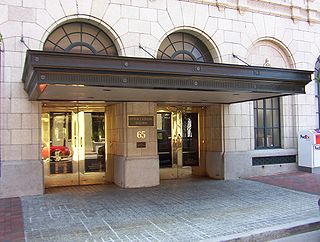
The Memphis Cotton Exchange is located in downtown Memphis, Tennessee, United States, on the corner of Front Street and Union Avenue. It was founded in 1874 as a result of the growing cotton market in Memphis, where trade was strong after the American Civil War. The first Cotton Exchange building was constructed in 1885. It was replaced by the Exchange Building in 1910, which housed it until a newer Cotton Exchange Building was completed in 1925.

Wilson Eyre Jr. was an American architect, teacher and writer who practiced in the Philadelphia area. He is known for his deliberately informal and welcoming country houses, and for being an innovator in the Shingle Style.
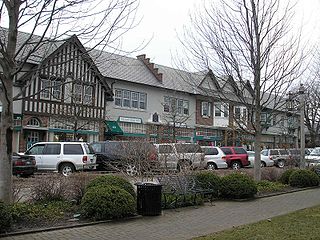
Howard Van Doren Shaw AIA was an architect in Chicago, Illinois. Shaw was a leader in the American Craftsman movement, best exemplified in his 1900 remodel of Second Presbyterian Church in Chicago. He designed Marktown, Clayton Mark's planned worker community in Northwest Indiana.
Samuel M. Plato (1882–1957) was an American architect and building contractor who is noted for his work on federal housing projects and U.S. post offices, as well as designing and building other structures in the United States such as private homes, banks, churches, and schools. During World War II, the Alabama native was one of the few African-American contractors in the country to be awarded wartime building contracts, which included Wake and Midway Halls. He also received contracts to build at least thirty-eight U.S. post offices across the country.

Walker & Gillette was an architectural firm based in New York City, the partnership of Alexander Stewart Walker (1876–1952) and Leon Narcisse Gillette (1878–1945), active from 1906 through 1945.
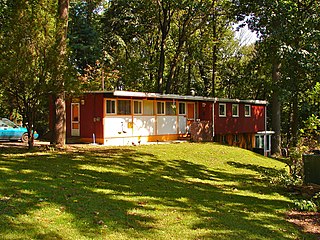
Greenbelt Knoll is a residential development in the Northeast section of Philadelphia, Pennsylvania. Planned and built from 1952 to 1957, it is notable as the first planned racially integrated development in Philadelphia and among the first in the United States.

William Lightfoot Price was an American architect, a pioneer in the use of reinforced concrete, and a founder of the utopian communities of Arden, Delaware and Rose Valley, Pennsylvania.
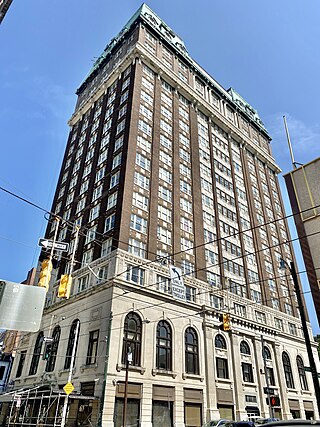
The Exchange Building is a 19-story skyscraper, which was formerly known as the Cotton Exchange Building and the Merchants Exchange Building, and is the twelfth-tallest building in Memphis, Tennessee. It should not be confused with the Memphis Cotton Exchange which is located on Front Street and Union Avenue. The Exchange Building is located at the corner of Second Street and Madison Avenue in downtown Memphis, Tennessee. It is 264.0 feet (80.5 m) tall and has 217,244 square feet (20,182.6 m2) of living space. The building is made of steel and concrete, and employs many decorative elements including Tennessee marble, granite, and detailed plaster work.

Perkins Center for the Arts is a regional arts center serving southern New Jersey and beyond since 1977. Perkins operates from a 1910 historic Tudor home and carriage building in Moorestown, New Jersey, and a former printing press in Collingswood, New Jersey.Perkins Center offers arts programs that promote participation, and understanding.

Stephen Decatur Button was an American architect and a pioneer in the use of metal-frame construction for masonry buildings. He designed commercial buildings, schools and churches in Philadelphia, Pennsylvania, and Camden, New Jersey; and more than 30 buildings in Cape May, New Jersey.
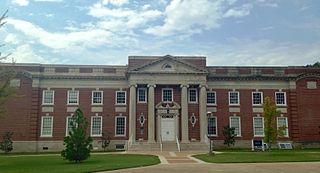
George Mahan Jr. was an American architect based in Memphis, Tennessee. He designed courthouses, many residences, and schools. Many of his designs were Neoclassical architecture style, and several buildings he designed are listed on the National Register of Historic Places (NRHP).

Everett Dedman Woods was an architect based in Memphis, Tennessee. He was the younger brother of fellow architect Neander Woods Jr. The Coca-Cola bottling plant he designed in Covington, Tennessee is listed on the National Register of Historic Places and a residence he built in Memphis became corporate headquarters for Harrah's Entertainment. He also designed East High School in Memphis.

The Tifton Residential Historic District, in Tifton, Georgia, is a historic district which was listed on the National Register of Historic Places in 2008.
Stockton Beekman Colt was an American architect noted for using the Renaissance style. A graduate of Columbia University, Colt apprenticed with George B. Post in New York City. In 1894, he was a founding partner in Trowbridge, Colt & Livingston with Goodhue Livingston and Samuel Beck Parkman Trowbridge.
















